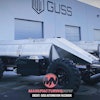C M M S F O R F O O D M A N U F A C T U R I N G
W W W . D P S I . C O M | 8 0 0 - 8 9 7 - 7 2 3 3
Complete Guide to Improving Your Food
Manufacturing Facility with a CMMS
What is a
CMMS and How
is it Used?
How to
Select the
Best CMMS
What Are the
Benefits for Food
Manufacturers?
Part 1: Part 2: Part 3:
P A R T 1
W W W . D P S I . C O M | 8 0 0 - 8 9 7 - 7 2 3 3
Computerized maintenance
management software is used for a
number of reasons. It streamlines all
relevant data for assets, making it easy
to determine which pieces of equipment
require maintenance and which
warehouses contain spare parts needed.
Maintenance staff utilize CMMS to create
and manage work orders, create work
requests, perform inventory control
functions and much more. Its use of real-
time data and robust reporting
functionality also helps management
make smarter asset management
decisions. For example, management can
calculate the cost of equipment
replacements and compare it to
preventative maintenance costs for each
asset. CMMS data may also be utilized to
demonstrate regulatory compliance.
Work Orders
Work Requests
Preventive Maintenance
Scheduling
Assets
Parts & Inventory
Purchasing
Projects
Reports & Graphs
Cost Tracking & Budgeting
What is CMMS Software?
A computerized maintenance
management system (CMMS) is a software
package that maintains a computer
database of information about an
organization's maintenance operations,
and is used to help maintenance workers
do their jobs more effectively.
How is it Used?
Typical CMMS Features:
WHAT I S CMMS SOFTWARE AND HOW I S I T USED ?
P A R T 2
W W W . D P S I . C O M | 8 0 0 - 8 9 7 - 7 2 3 3
Comply with Food Safety Regulations
There are a number of entities that regulate the food manufacturing industry—United States
Department of Agriculture (USDA), Food and Drug Administration (FDA) and the ISO 22000
family of International Standards just to name a few. To ensure food manufacturers are
Aside from affecting production, interruptions in the food manufacturing process can cause
significant waste. Food that can’t be processed in a timely manner due to an equipment
malfunction or failure must be scrapped due to health and safety concerns. CMMS software
decreases the likelihood of equipment breakdowns by ensuring preventive maintenance is
performed on a regular basis. This helps maintenance teams operate more efficiently and
reduce waste. Access to real-time information also allows staff to also track inventory levels
more effectively, which helps prevent over-ordering.
meeting health and regulations,
these entities conduct inspections
and audits. CMMS software provides
a means to store detailed
documentation such as safety
manuals, standard operating
procedures and important records
related to equipment and assets. A
few clicks (or taps, if you’re using a
mobile device) is all it takes to
retrieve pertinent data needed to
demonstrate compliance. You can
even generate custom reports for
inspectors and auditors using food
manufacturing CMMS software.
WHAT ARE THE BENEF I T S FOR FOOD MANUFACTURERS ?
Reduce Food Waste
Maximize Equipment Reliability
Food manufacturers require reliable equipment to succeed. Any interruption in food
processing can seriously affect production and, more importantly, profits. Regular preventive
maintenance is necessary in order to maximize equipment reliability. Food manufacturing
CMMS software allows users to effectively plan, schedule and record preventive maintenance
activities on each piece of equipment. Maintenance software helps maximize uptime and
keep equipment operating in peak condition.
P A R T 3
W W W . D P S I . C O M | 8 0 0 - 8 9 7 - 7 2 3 3
Access to a comprehensive history on each asset, including dates when failures occurred and
repairs were performed, helps management make smarter asset management decisions. For
example, each asset has an average lifecycle and budgets typically allocate funds toward
replacement when that asset has reached its end of life. However, with regular preventive
maintenance performed and very few unplanned repairs, that asset may well exceed its
average lifecycle. Management may opt to delay equipment replacement and instead
allocate those available funds toward other pressing matters.
HOW TO SE LECT THE BEST CMMS
Make Smarter Asset Management Decisions
Modernize Your Maintenance Operations
If you are still utilizing spreadsheets to organize your maintenance operations, it’s time for a
change. Whereas spreadsheets are limited in capabilities, CMMS software provides
automation of tasks, centralization of data, detailed analysis, advanced reporting and more.
Most reputable maintenance software solutions offer the ability to access the program on
any web-based device, including mobile. Maintenance staff can manage work orders, work
requests, and parts inventory on the go with ease. Dashboard features within CMMS software
enable companies to view real-time data on a number of key performance indicators (KPIs)
graphically at any time. This allows management to keep a finger on the pulse of their
organization, spot trends and improve efficiency.
1. Assemble a CMMS Team
To begin the selection process, organizations should put together a CMMS selection and
implementation team to work through selection criteria. This enables representatives from
management, maintenance, operations and accounting functions to work together and
determine critical requirements for CMMS software.
Consider questions like:
How many pieces and types of equipment will be tracked in the system?
How many users will there be and how will they access the system (mobile devices or
workstations)?
What type of deployment option is best: an on-premise system with a private cloud option
or a hosted cloud-based system?
What are the critical reports and key performance indicators (KPIs) that we need to track
using the system?
Will the CMMS system need to integrate with our other business applications?
W W W . D P S I . C O M | 8 0 0 - 8 9 7 - 7 2 3 3
Another very important consideration when selecting a CMMS system are your asset
management standard operating procedures (SOPs). Once SOPs are defined, different CMMS
products can be appropriately evaluated to ensure they meet your requirements. Can you
easily customize the CMMS product to meet your specific needs? A common reason CMMS
implementations fail is a mismatch between how a system is designed and how your work is
actually performed.
2. Develop Standard Operating Procedures (SOPs)
Once you've completed the groundwork to determine the requirements for your business and
the key deliverables of the CMMS, you can easily develop a shortlist of vendors to evaluate
before a final selection is made.
3. Narrow Down List of CMMS Vendors
The following criteria can help determine whether a vendor should be placed on the short
list:
Does the product have the features that meet your list of requirements?
Does the vendor have a proven track record in the CMMS industry, and do they obtain
input from customers for product improvements?
Does the vendor provide training and support services at a level that meets your
expectations?
What is the user interface like, and how easily can your staff become familiar with the
functionality?
Can the user interface be easily modified by you?
Does the product and services match your budget?
Ultimately, the best CMMS software selection for you is a combination of many factors and
priorities that are unique to your business.
Contact DPSI
DPSI provides industry-leading CMMS software
solutions that help organizations resolve
critical maintenance challenges, maximize
ROI, enhance productivity, ensure compliance
and more. We accommodate a variety of industries ranging from small to large multi-site
organizations. We offer highly scalable software solutions that can be accessed online from
any web-based device. Since 1986, our company has served over 6,000 companies and
50,000 users in over 50 countries, including more than 400 of the Fortune 500 companies.
Complete Guide to Improving Your Food Manufacturing Facility with a CMMS
Computerized maintenance management system (CMMS) software maintains a database of information about an organization's maintenance operations and helps workers do their jobs more effectively. For food manufacturers in particular, a CMMS can ensure compliance with food safety regulations, reduction in food waste, and maximum equipment reliability.
Latest in Home





















